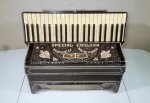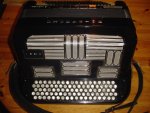I have a few questions about some older excelsiors, the really older ones that say special model, all in fancy rhinestones. Here is a picture of one:
Ive seen on a few of them on the master palm switch it says Pietros system. Im assuming its after pietro diero?, maybe pietro frosini, but Im assuming deiro since he played a piano accordion. But maybe a palm switch could have been on frosinis accordion too, I dont know. Anyway what is the system? What is it referring to here? Were these the first palm registers? Also sometimes there are two shifts on these, Im not sure what the other one is called?
Just curious! Thanks again.
Ive seen on a few of them on the master palm switch it says Pietros system. Im assuming its after pietro diero?, maybe pietro frosini, but Im assuming deiro since he played a piano accordion. But maybe a palm switch could have been on frosinis accordion too, I dont know. Anyway what is the system? What is it referring to here? Were these the first palm registers? Also sometimes there are two shifts on these, Im not sure what the other one is called?
Just curious! Thanks again.



